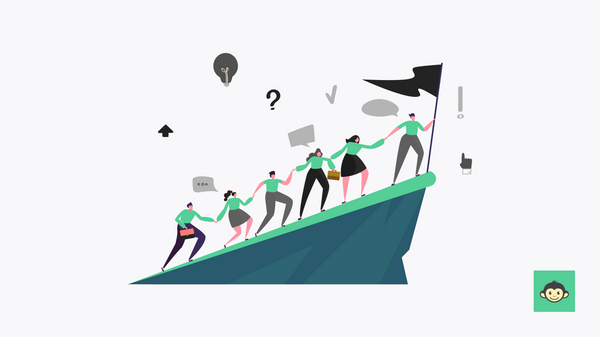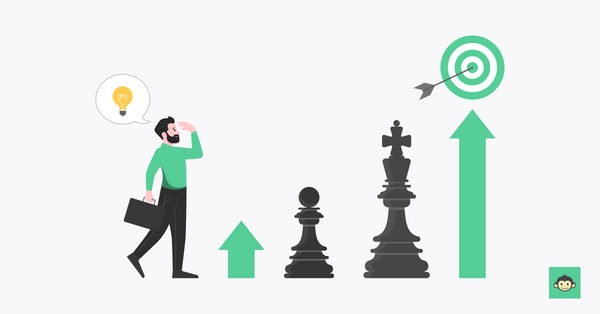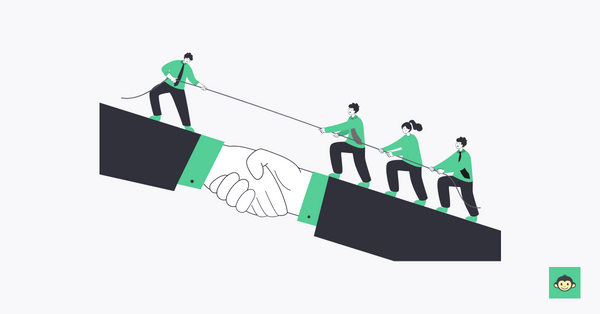


As organizations recognize the indispensable role of adept leaders in driving innovation, fostering engagement, and ensuring sustained success, the demand for strategic leadership development has soared. According to a report by Deloitte, 86% of executives identified leadership as one of their most pressing issues.
In this blog, we will explore the art of crafting the perfect leadership development plan. We have compiled practical tips, actionable strategies, and illuminating examples to help you create a roadmap to hone your leadership acumen and propel your organization toward triumph.

A leadership development plan is a structured and personalized strategy designed to enhance an individual's leadership skills, competencies, and qualities. It serves as a roadmap for leaders to identify their strengths, weaknesses, and areas for growth, and to outline specific actions for improvement.
This plan typically includes a combination of skill-building activities, training programs, mentorship opportunities, and self-assessment mechanisms.
A well-crafted leadership development plan involves several key components, such as setting clear goals, identifying relevant training or learning experiences, establishing a timeline for skill enhancement, and regularly evaluating progress.
The plan may focus on various leadership dimensions, including communication, decision-making, emotional intelligence, conflict resolution, and strategic thinking.

A proper leadership development strategy plan holds immense significance in the modern workplace due to several compelling reasons:
The modern workplace is characterized by rapid technological advancements, global markets, and intricate challenges. Effective business leaders need to navigate this complexity with agility, adaptability, and strategic thinking.
Leadership development nurtures a pipeline of capable leaders. As the workforce evolves, organizations must cultivate a pool of skilled individuals who can step into various leadership positions and roles seamlessly.
Empowered and well-trained leaders create an environment of trust, open communication, and growth. This positively impacts employee morale, job satisfaction, and overall engagement.
Modern workplaces often undergo transformational changes. Leaders equipped with the skills to manage change effectively can guide their teams through transitions, reducing resistance and disruptions.
Leadership development fosters innovative thinking and problem-solving. Leaders who encourage creativity within their teams drive the organization's ability to adapt and innovate.
Today's workforce comprises diverse backgrounds, experiences, and perspectives. Leaders must possess cultural competence nurture leadership skills, and inclusivity skills to harness the strengths of this diversity.
Organizations require a smooth transition of leadership as senior leaders retire or move on. A well-structured development plan ensures a continuous flow of leaders ready to step into higher roles.
Effective leadership directly impacts an organization's performance and competitiveness. Developing leaders who can drive growth, innovation, and profitability becomes a strategic advantage.
Leaders influence employee growth and development. Skilled leaders can mentor and guide their teams, helping individuals reach their full potential.
In a dynamic and often high-pressure workplace, conflicts are inevitable. Leaders trained in conflict resolution can mediate disputes effectively, fostering a harmonious and productive work environment.
Leadership development plays a critical role in shaping and maintaining a positive organizational culture. Leaders who embody and promote the company's values and vision contribute to a cohesive and motivated workforce.

Creating a robust leadership development plan requires careful consideration to ensure its effectiveness and relevance. Here are some unique and creative points to ponder:
By embracing these creative considerations, your leadership development plan becomes a dynamic and innovative tool that propels you toward effective and impactful leadership.

Implementing a leadership development plan is a strategic endeavor that can lead to transformative growth within an organization. However, numerous challenges may arise during this process, necessitating careful consideration and planning. Here are nine common challenges and insights on how to overcome them:
Pinpointing individuals with leadership potential can be complex. In a dynamic workforce, talent can be hidden in unexpected places.
Mitigate this challenge by establishing a comprehensive assessment process that evaluates not just current skills, but also attributes like adaptability, emotional intelligence, and problem-solving capabilities.
Crafting personalized leadership development plans can be intricate. Generic approaches won't suffice. Overcome this by conducting thorough assessments to understand each individual's strengths and areas needing improvement.
Customize training modules, coaching, and mentoring to align with these unique needs.
Leaders already managing their roles may find it challenging to allocate time for development activities. Striking a balance entails integrating leadership development seamlessly into their routines.
Utilize microlearning modules, brief coaching sessions, and peer mentoring to deliver impactful content without overwhelming their schedules.
Gaining buy-in from both upper management and potential leaders is crucial. Leaders may be hesitant to invest time, and upper management might be concerned about diverting resources.
Address this challenge by presenting the tangible benefits of leadership development, such as improved team performance, succession planning, and long-term organizational sustainability.
Maintaining enthusiasm and engagement throughout the development journey can be tough. Combat this by structuring the plan as a continuous learning process. Incorporate milestone celebrations, gamification elements, and regular progress assessments to keep participants motivated.
The landscape of leadership evolves, requiring plans to be flexible. Develop a plan that integrates feedback loops and periodic assessments, enabling adjustments as leaders' roles and organizational priorities evolve.
Demonstrating the impact of a leadership development plan on the organization's success can be challenging. Implement robust metrics that evaluate not only quantitative results like increased productivity but also qualitative outcomes like improved team collaboration and innovation.
Different cultural backgrounds can impact leadership styles and development processes. Address this by promoting cultural awareness and sensitivity training within your leadership programs to ensure inclusivity and effective communication.
Leveraging technology for leadership development can be daunting. Ensure that your organization is equipped with the necessary tools and platforms for virtual training, e-learning, and collaboration to enhance accessibility and engagement.
By addressing these challenges proactively, organizations can navigate the complexities of implementing a leadership development plan, ensuring that the growth of future leaders aligns seamlessly with the organization's goals and vision.

Setting effective leadership development plan goals involves a systematic and thoughtful approach. Here's a structured process to guide you in creating leadership development plans:
Remember, a well-crafted leadership development plan is a dynamic document that evolves as you grow. It's a roadmap that guides your journey towards becoming a more effective and impactful leader.

A leadership development plan template provides a structured framework to outline your goals, actions, and timeline for enhancing your leadership skills. While there are various formats, here's a comprehensive template to guide you:
Customize this template to suit your specific goals, preferences, and the unique demands of your leadership role. Remember, an effective leadership development plan is a living document that evolves with your growth journey.

Here are five diverse leadership development plan examples that can serve as inspiration for crafting your own personalized plan:
Goal: Enhance communication skills to foster clearer interactions with team members.
Actions: Attend public speaking workshops, practice active listening, engage in cross-functional discussions, and seek feedback on communication effectiveness.
Milestones: Successfully led a large team meeting, gave a presentation at a company event, and mentored a colleague on effective communication.
Goal: Develop inclusive leadership skills to foster diversity and equity within the team.
Actions: Participate in diversity and inclusion training, establish an employee resource group, facilitate open discussions on diversity, and mentor diverse talent.
Milestones: Implement diversity initiatives, create an inclusive team culture, and observe an increase in team collaboration and innovation.
Goal: Cultivate innovative thinking to address complex challenges more creatively.
Actions: Attend design thinking workshops, encourage brainstorming sessions, explore new technologies, and promote a culture of experimentation.
Milestones: Successfully lead a cross-functional innovation project, introduce a new process that improves efficiency, and receive recognition for innovative contributions.
Goal: Develop skills to lead teams through organizational changes with resilience and empathy.
Actions: Enroll in change management courses, hold town hall meetings to address concerns, provide one-on-one coaching to team members during transitions, and lead by example during change.
Milestones: Successfully guide a major organizational change, observe minimal resistance from team members, and witness a positive impact on employee morale and performance.
Goal: Enhance strategic thinking abilities to create a long-term vision for the team's growth.
Actions: Attend strategic planning workshops, analyze industry trends, conduct SWOT analysis for the team, and collaborate with senior leaders on long-term goals.
Milestones: Develop a comprehensive team growth strategy, witness improved alignment of team efforts with organizational goals, and contribute to achieving significant milestones.
These examples showcase how leadership development plans can be tailored to various skill sets and aspirations.
Drawing inspiration from these diverse approaches can help you shape a plan that aligns with your goals and empowers your journey as a leader. The importance of a leadership development plan lies in its ability to provide a structured framework for continuous improvement.
It helps leaders evolve in response to the changing demands of their roles and the dynamic business landscape. Moreover, an effective leadership development plan benefits both individuals and organizations by nurturing a pool of capable and adaptable future leaders, promoting employee engagement, and contributing to long-term organizational success.
A leadership development plan is a strategic roadmap designed to enhance leadership skills and competencies. It outlines goals, actionable steps, and a timeline for personal growth, enabling individuals to evolve into effective and impactful leaders.
Start by assessing your current skills, strengths, and areas for improvement. Identify your long-term career goals and align them with the skills you want to develop. Set SMART goals (Specific, Measurable, Achievable, Relevant, Time-bound) and create an actionable plan to achieve them.
A well-rounded plan includes clear goals, targeted skill enhancement strategies, a timeline for implementation, resources required (courses, workshops, mentorship), and mechanisms for feedback and evaluation.
Mentoring can be a powerful tool. Seek mentors who possess the skills you aim to develop. Engage in reverse mentoring, where you learn from younger colleagues. Virtual mentoring and online platforms can also provide diverse perspectives.
Certainly. An example could be a mid-level manager aiming to enhance communication skills for effective team collaboration. Their plan might involve attending a communication workshop, reading influential books, leading cross-functional projects, and practicing active listening. Milestones could include successfully facilitating team discussions and achieving improved project outcomes.
This leadership development plan is for current and aspiring leaders, including managers, team leaders, and high-potential employees. It is designed to enhance leadership skills, prepare individuals for greater responsibilities, and ensure a steady pipeline of capable leaders within the organization. It benefits anyone seeking personal and professional growth in leadership roles.
Kailash is a Product Marketer with 5+ years of experience. He loves story-telling in the simplest way possible and he is an avid reader, movie buff, and likes to travel new places to meet new people.